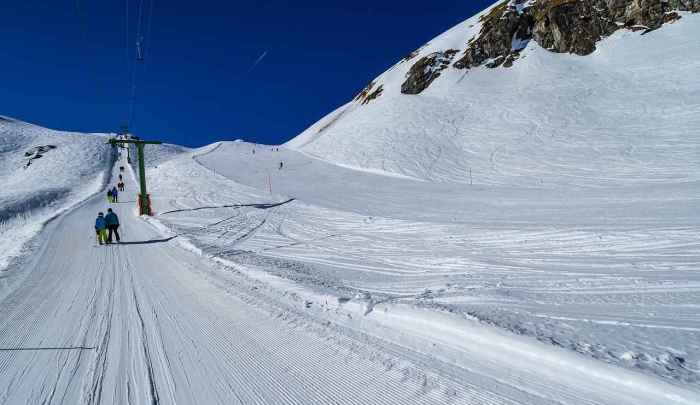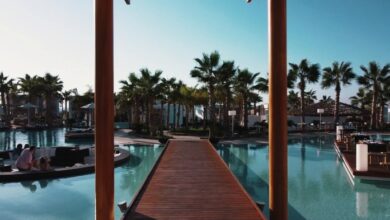Best Ski Resorts And Hotels In Switzerland Your Ultimate Guide

Best Ski Resorts And Hotels In Switzerland beckons with a promise of unparalleled winter adventures. From the breathtaking Alps to world-class resorts and luxurious hotels, Switzerland offers an unparalleled skiing experience. This comprehensive guide explores the diverse terrain, highlighting the best ski resorts and hotels, catering to every budget and preference, from family-friendly fun to lavish indulgence. Discover the history, activities, and essential travel information needed to plan your dream Swiss ski vacation.
This detailed guide delves into the Swiss ski scene, comparing top resorts based on terrain, lift access, and snow reliability. It provides in-depth analyses of accommodation options, from cozy chalets to luxurious hotels, catering to varying budgets. The guide also covers a range of winter activities, from thrilling off-piste adventures to cultural explorations. Furthermore, it includes essential travel information, covering transportation, visa requirements, and local customs.
Introduction to Swiss Ski Resorts
Switzerland’s reputation as a premier ski destination is well-earned. The country boasts a stunning array of ski resorts, catering to every level of skier and snowboarder, from beginners to seasoned experts. This diverse offering is underpinned by a commitment to high-quality facilities and a rich history. Beyond the exhilarating slopes, the Swiss ski experience seamlessly integrates luxury and breathtaking scenery.The geographical spread of Swiss ski resorts is remarkable.
From the breathtaking Alps in the west to the eastern regions, numerous resorts dot the landscape, each with its own distinct character and attractions. The varied terrain ensures a unique experience for every visitor. This variety, combined with the excellent infrastructure, contributes significantly to Switzerland’s position as a leading global ski tourism hub.
Geographical Distribution of Ski Areas
Switzerland’s ski resorts are strategically located across different regions, each offering a distinct alpine experience. The Swiss Alps are divided into several major areas, each with its own unique character. The western Alps, encompassing regions like the Valais and the Bernese Oberland, are renowned for their challenging slopes and stunning views of the surrounding peaks. The central Swiss Alps offer a more accessible entry point to the sport, with gentle slopes suitable for beginners and families.
Eastern Switzerland, particularly the Graubünden region, provides access to high-altitude, extensive ski areas. These regions offer varied landscapes and experiences, ensuring a tailored ski vacation for every visitor.
Historical Significance of Skiing in Switzerland
Skiing has a long and proud tradition in Switzerland, deeply rooted in the country’s culture and landscape. The rugged terrain and mountainous environment fostered early development of skiing techniques. From humble beginnings as a practical mode of transportation and winter survival, skiing evolved into a major recreational activity, attracting visitors from around the world. The development of modern ski resorts, combined with a commitment to high-quality infrastructure, transformed skiing into a significant driver of tourism.
This evolution cemented Switzerland’s position as a world-class destination for winter sports enthusiasts.
Key Characteristics of Swiss Ski Resorts
Swiss ski resorts are distinguished by a number of key characteristics. The diverse terrain is one of the most attractive features, catering to skiers of all skill levels. From gentle slopes perfect for beginners to challenging off-piste adventures, the varied options cater to all skill levels and preferences. High-quality facilities, including well-maintained slopes, modern ski lifts, and comfortable accommodations, contribute to a seamless and enjoyable experience.
Luxury options, from exclusive chalets to five-star hotels, further enhance the allure of a Swiss ski holiday. These characteristics, combined with the breathtaking natural beauty, are the hallmarks of the Swiss ski experience.
Best Ski Resorts

Switzerland boasts a diverse range of world-class ski resorts, catering to various interests and budgets. From challenging off-piste adventures to serene family-friendly slopes, the country offers unparalleled skiing experiences. This section delves into the top resorts, comparing their features, and highlighting their unique selling points.The choice of a perfect ski resort hinges on individual preferences. Consider the terrain, lift access, and snow reliability when making your decision.
Family-friendly amenities and luxury accommodations are equally important factors for some travelers.
Top-Tier Ski Resorts Compared
Different resorts excel in different areas. Zermatt, known for its breathtaking scenery and challenging terrain, attracts experienced skiers. Meanwhile, Engelberg, with its well-maintained slopes and diverse options, appeals to a wider range of skiers, including families. Wengen, nestled in the Bernese Oberland, offers a charming village atmosphere and excellent snow conditions. These resorts, each with its own distinctive character, showcase the excellence of Swiss skiing.
Family-Friendly Resorts
Family-friendly resorts prioritize amenities designed for children and families. Gstaad, for example, offers dedicated ski schools, children’s play areas, and snow activities. Crans-Montana, another prominent choice, boasts extensive nursery slopes and kid-friendly terrain parks. These resorts are often equipped with a range of activities that cater to all ages, providing an enjoyable experience for families.
Luxury Resorts and Amenities
Luxury resorts in Switzerland offer unparalleled amenities and experiences. St. Moritz, famed for its opulent hotels and exclusive atmosphere, provides exceptional service and lavish accommodations. Verbier, with its stunning mountain views and luxurious chalets, delivers a unique blend of sophistication and outdoor adventure. These resorts often include exclusive access to premium services, fine dining, and personalized experiences, elevating the skiing experience to new heights.
Top 5 Ski Resorts
| Resort | Location | Terrain | Average Snowfall (cm) |
|---|---|---|---|
| Zermatt | Valais | Challenging, varied terrain, including off-piste options | 300-400 |
| Gstaad | Bernese Oberland | Well-maintained slopes, suitable for all levels | 250-350 |
| Engelberg | Central Switzerland | Extensive network of slopes, varied terrain | 280-380 |
| St. Moritz | Graubünden | High-altitude slopes, challenging runs, extensive glacier skiing | 350-450 |
| Verbier | Valais | Challenging terrain, off-piste skiing, excellent après-ski | 280-360 |
Accommodation Options
Switzerland’s renowned ski resorts offer a diverse range of accommodation options to suit various budgets and preferences. From luxurious hotels with gourmet dining experiences to cozy chalets providing a unique Alpine retreat, the choice caters to every traveler. This section details the diverse accommodations available, comparing and contrasting options across price ranges, and highlighting essential amenities.
Hotel Categories by Budget, Best Ski Resorts And Hotels In Switzerland
Different hotels cater to different budgets. Luxury hotels typically boast premium amenities, exclusive services, and exceptional dining options. Mid-range hotels strike a balance between comfort and value, offering a variety of services at competitive prices. Budget-friendly options provide basic necessities while remaining reasonably priced, often with a focus on practicality.
Types of Accommodation
Beyond hotels, Switzerland offers diverse accommodation options. Chalets provide a more intimate and secluded experience, often with private kitchens and spacious living areas. Apartments, particularly in popular ski villages, offer more space and self-catering facilities, perfect for families or groups. Hotels, in various categories, provide a comprehensive range of services, including dining, concierge assistance, and often, access to the resort’s facilities.
Hotel Chains in Swiss Ski Resorts
Several prominent hotel chains operate in Swiss ski resorts. These chains often provide a consistent level of service and amenities across different locations, making it easier to plan travel. Comparing their strengths and weaknesses reveals nuances in service quality, room sizes, and overall resort experience.
Comparison of Hotel Features
| Hotel Budget | Spa Facilities | Dining Options | Room Amenities |
|---|---|---|---|
| Luxury | Extensive spa facilities, including thermal baths, saunas, and massage therapies. Often featuring private treatment rooms and highly skilled therapists. | Multiple dining options, ranging from fine-dining restaurants to casual cafes, offering a variety of cuisines. Often with dedicated sommeliers and extensive wine lists. | High-quality furnishings, luxurious bedding, spacious layouts, and premium toiletries. May include balconies or terraces with mountain views. |
| Mid-Range | Basic spa facilities, including saunas and steam rooms. May offer massage services, but often with fewer options. | Diverse dining options, from casual restaurants to themed dining experiences. May include buffet options or themed menus. | Comfortable furnishings, standard amenities, and adequate room sizes. May feature mountain views or balconies in some rooms. |
| Budget | Limited spa facilities, often basic saunas or steam rooms. May not offer massage services. | Simple dining options, focusing on practicality. May include self-service buffets or a limited menu. | Basic furnishings, standard amenities, and smaller room sizes. May not offer balconies or terraces. |
Activities and Experiences
Beyond the majestic slopes, Swiss ski resorts offer a vibrant tapestry of winter activities, catering to diverse interests and skill levels. From thrilling off-piste adventures to cultural explorations, the experience extends far beyond simply hitting the slopes. These destinations blend breathtaking scenery with enriching experiences, promising an unforgettable winter getaway.
Winter Sports Beyond Skiing
Swiss resorts are renowned for their comprehensive winter sports offerings. Beyond the well-known skiing and snowboarding, snowshoeing and ice skating provide alternatives for those seeking a less strenuous yet equally enjoyable experience. These activities provide a chance to immerse in the serene beauty of the snowy landscape at a slower pace.
- Snowshoeing: Embark on scenic treks through pristine snow-covered landscapes. Snowshoeing trails often weave through picturesque forests and alongside sparkling streams, offering opportunities for wildlife viewing and breathtaking vistas. Various difficulty levels cater to all abilities, making it an accessible activity for families and individuals alike.
- Ice Skating: Many resorts boast dedicated ice skating rinks, providing a chance to glide across the frozen surface under the backdrop of the Alps. The ambiance of ice skating, especially at night, is particularly magical, creating a memorable experience.
Off-Piste Adventures and Excursions
The Swiss Alps offer a plethora of off-piste opportunities for adventurous souls. Expert guides can lead thrilling excursions through untouched powder, allowing skiers and snowboarders to explore hidden gems beyond the marked trails. These experiences often include breathtaking panoramic views and the satisfaction of conquering challenging terrain. Safety considerations are paramount, emphasizing the importance of hiring experienced guides and being aware of weather conditions.
- Guided Tours: Numerous guided tours cater to different skill levels and interests, ensuring a safe and enjoyable experience. From challenging off-piste adventures to leisurely snowshoe treks, these tours provide the opportunity to explore the region’s hidden corners.
- Heli-Skiing/Heli-boarding: For the truly adventurous, heli-skiing or heli-boarding offers access to untouched slopes, providing an unparalleled experience of alpine grandeur. This activity, however, typically requires a higher level of experience and can be more costly.
Cultural and Historical Immersion
The Swiss ski regions often intertwine with rich cultural and historical elements. Many resorts feature charming villages with traditional architecture, offering insights into the region’s past. Local museums and historical sites provide deeper understanding of the region’s heritage and the lives of the people who shaped it.
- Visiting Local Villages: Exploring the villages surrounding the ski resorts provides a glimpse into the local culture. Traditional architecture, local crafts, and the way of life are preserved, offering a fascinating glimpse into Swiss history and heritage.
- Museums and Historical Sites: Numerous museums and historical sites in the region offer insight into the area’s history, from its alpine past to its modern development. These venues provide a rich cultural context to the ski experience.
Winter Activities Table
| Activity | Difficulty Level | Recommended Locations |
|---|---|---|
| Skiing | Beginner to Expert | Zermatt, St. Moritz, Grindelwald |
| Snowboarding | Beginner to Expert | Davos, Verbier, Wengen |
| Snowshoeing | Beginner to Moderate | Interlaken, Saas-Fee, Engelberg |
| Ice Skating | Beginner | All major resorts |
| Off-Piste Skiing | Expert | Zermatt, Verbier, Chamonix (France, close to Switzerland) |
Travel and Transportation
Switzerland’s renowned ski resorts are easily accessible thanks to a sophisticated transportation network. This efficient system allows visitors to seamlessly navigate between resorts and enjoy the diverse landscapes. The country’s commitment to connectivity extends beyond just the ski areas, encompassing the wider region, offering a unique travel experience.The interconnectedness of Switzerland’s train network, coupled with efficient bus services, provides a convenient and scenic journey to various ski destinations.
This robust transportation infrastructure ensures that getting around is effortless, making the most of the mountainous terrain and alpine scenery.
Train Networks
Switzerland boasts an extensive and reliable rail network that connects major cities and towns, including those surrounding the ski resorts. This system is a significant contributor to the accessibility of the country’s ski areas. The frequent and punctual train schedules offer a comfortable and scenic way to travel. High-speed trains often connect major cities, allowing for rapid transit between destinations.
Bus Services
Complementing the train network, bus services offer a vital link to more remote ski areas and smaller villages. Bus routes are strategically designed to reach various ski resorts and surrounding communities, facilitating travel between destinations not directly served by trains. These services often provide a cost-effective and flexible alternative to train travel, especially for shorter distances.
Ski Lift Access
Within the ski resorts, ski lifts provide an efficient and enjoyable way to navigate the slopes. This system of lifts, gondolas, and cable cars offers a direct connection to various trails and peaks, facilitating the movement of skiers and snowboarders between different areas. The ski lift system is often integrated with the wider transportation network, allowing for seamless transitions between train or bus travel and on-mountain activities.
Inter-Resort Connections
The transportation system extends beyond individual resorts, connecting various ski regions. This interconnectedness allows skiers to explore different areas and enjoy a diverse range of terrain without needing to switch accommodations or repeatedly use the train system. For example, several ski areas are connected by shared lift systems, offering an integrated experience.
Transportation Comparison
| Transportation | Cost | Time | Convenience |
|---|---|---|---|
| Train | Moderate to high | Variable, often longer | High, scenic routes, frequent schedules |
| Bus | Low to moderate | Variable, often longer | Moderate, less frequent schedules |
| Ski Lift | Moderate | Short | High, direct access to slopes |
This table provides a basic comparison of different transportation options. Actual costs and times may vary depending on specific routes and seasons.
Essential Information
Planning a trip to the Swiss Alps requires careful consideration of various factors. Understanding the optimal time to visit, visa procedures, local customs, and safety precautions will ensure a memorable and enjoyable experience. This section provides crucial information to prepare for your adventure.Switzerland boasts stunning landscapes throughout the year, but the winter months offer unique opportunities for skiing, snowboarding, and other winter sports.
Knowing the best time to visit can significantly impact your experience, from optimal snow conditions to manageable crowds.
Best Time to Visit
The ideal time for skiing in Switzerland typically falls between December and April. This period offers consistent snowfall, allowing for excellent conditions on the slopes. However, peak season (Christmas and New Year’s) and spring skiing can lead to higher prices and larger crowds. Shoulder seasons (November/early December and late March/early April) often offer a good balance of favorable weather and fewer crowds, making them attractive alternatives.
Consider your priorities: excellent snow versus fewer crowds.
Visa Requirements
Visa requirements for Swiss ski resorts vary depending on the nationality of the visitor. International travelers should check the official website of the Swiss embassy or consulate in their home country for specific visa requirements and procedures. These requirements are frequently updated, so it’s essential to verify the most current information before booking your trip. This proactive step will prevent any unexpected travel disruptions.
Currency Exchange and Payment Methods
The Swiss Franc (CHF) is the official currency of Switzerland. Many establishments accept major international credit cards and debit cards. However, it’s always a good idea to have some Swiss francs on hand for smaller purchases or less-accessible locations. Currency exchange services are readily available in airports and major cities. Before your trip, confirm exchange rates to plan your budget accordingly.
Local Customs and Etiquette
Switzerland is renowned for its punctuality, efficiency, and politeness. Showing respect for local customs and traditions is crucial for a positive experience. Be mindful of queuing etiquette and maintain a respectful demeanor in public spaces. Learn a few basic Swiss German phrases to enhance your interactions with locals. For instance, “Danke” (thank you) and “Guten Tag” (good day) are valuable phrases to know.
Safety Precautions in Winter Activities
Winter activities in the Swiss Alps require careful consideration of safety precautions. Always check weather forecasts before heading out to the mountains and inform someone of your itinerary. Wear appropriate clothing for the conditions, including waterproof jackets and sturdy footwear. Be aware of potential hazards like icy patches, avalanches, and changing weather conditions. Never venture into unknown areas without a guide or appropriate safety equipment.
Switzerland’s renowned ski resorts and hotels offer unparalleled winter experiences. However, exploring the diverse range of accommodations available beyond the slopes is equally captivating. For a different perspective on luxurious hospitality, consider Discovering the Allure of Hotels in the Netherlands , a fascinating alternative. Ultimately, the choice of where to stay in Europe, whether amidst the snowy peaks of the Alps or the charming canals of the Netherlands, depends on personal preference.
Exceptional accommodations are available throughout Switzerland.
Skiing or snowboarding outside marked trails carries inherent risks. Assess your own abilities and experience level.
Useful Phrases in Swiss German
Learning some basic Swiss German phrases can enhance your interactions with locals. While many people in tourist areas speak English, knowing some local phrases demonstrates respect and can lead to more meaningful conversations.
- Guten Tag: Good day
- Danke: Thank you
- Bitte: You’re welcome
- Entschuldigung: Excuse me
- Wie geht es Ihnen?: How are you?
Expert Tips and Recommendations: Best Ski Resorts And Hotels In Switzerland
Planning a Swiss ski trip requires careful consideration. Beyond simply choosing a resort, savvy travelers understand the nuances of booking, budgeting, and maximizing their time on the slopes. This section provides expert advice to help you craft an unforgettable Swiss ski adventure.Effective planning is key to a successful trip. Advance booking for accommodations and popular activities, such as ski lessons or guided tours, is highly recommended.
This proactive approach minimizes stress and ensures availability, especially during peak season.
Booking Accommodations and Activities
Advance booking is crucial for securing the best deals and preferred accommodations. Many resorts offer various packages, including lift passes, ski rentals, and meals. Consider booking these packages in advance to potentially save money and streamline your travel experience. Also, look for last-minute deals and promotions offered by resorts or travel agencies.
Dining Experiences
Swiss cuisine offers a diverse range of culinary experiences. Beyond the traditional fondue and raclette, many restaurants serve modern interpretations of Swiss classics, showcasing local ingredients and flavors. Explore local restaurants and try regional specialties. Check online reviews and recommendations to find restaurants that align with your preferences and budget. For example, a cozy chalet-style restaurant might offer a more authentic experience compared to a large, upscale dining venue.
Essential Gear and Clothing
Proper gear and clothing are essential for a comfortable and safe ski trip. Layers are crucial, allowing you to adjust to varying weather conditions. Pack waterproof jackets and pants, warm base layers, and insulated mid-layers. Don’t forget warm socks, gloves, and a hat. Consider investing in high-quality ski boots, ensuring they fit well and provide adequate support.
Check the weather forecast before your trip and pack accordingly.
Maximizing Your Ski Season Experience
To make the most of your time on the slopes, consider booking ski lessons, taking advantage of guided tours, and exploring off-piste opportunities. For example, booking ski lessons can significantly improve your skiing skills and confidence, and taking advantage of guided tours can introduce you to the local culture and hidden gems. Learn about the different ski areas and choose the ones that best suit your skill level.
Remember to take breaks and rest between runs to prevent fatigue and injury.
Budgeting and Cost-Saving Strategies
Skiing in Switzerland can be expensive. To stay within budget, consider off-season travel, when prices are often lower. Look for deals and discounts on accommodation, lift passes, and ski rentals. Alternatively, consider purchasing a multi-day lift pass for better value, especially if you plan to ski for several days. Packing your own lunch and snacks can also help reduce dining costs.
Also, consider utilizing public transportation options to reduce transportation expenses.
Final Conclusion
In conclusion, Switzerland’s ski resorts and hotels offer a perfect blend of breathtaking scenery, world-class facilities, and unforgettable experiences. This comprehensive guide has provided a detailed overview, allowing you to select the ideal ski resort and accommodation that matches your preferences and budget. From the thrill of skiing down pristine slopes to the comfort of luxurious hotels, Switzerland promises an unparalleled winter adventure.
Plan your trip today and embark on an unforgettable journey through the heart of the Alps!




